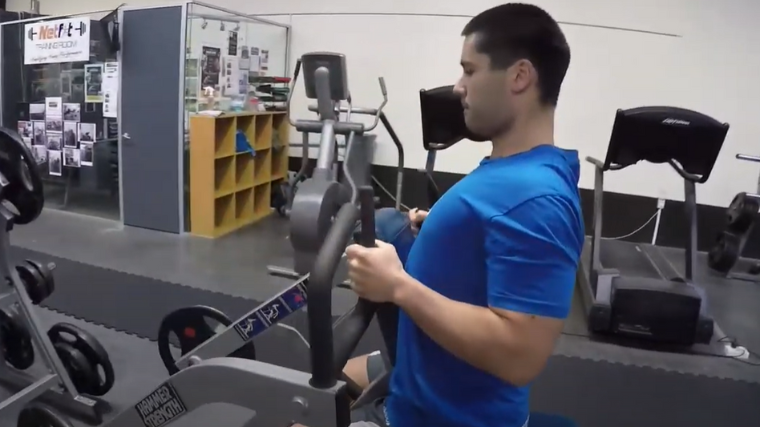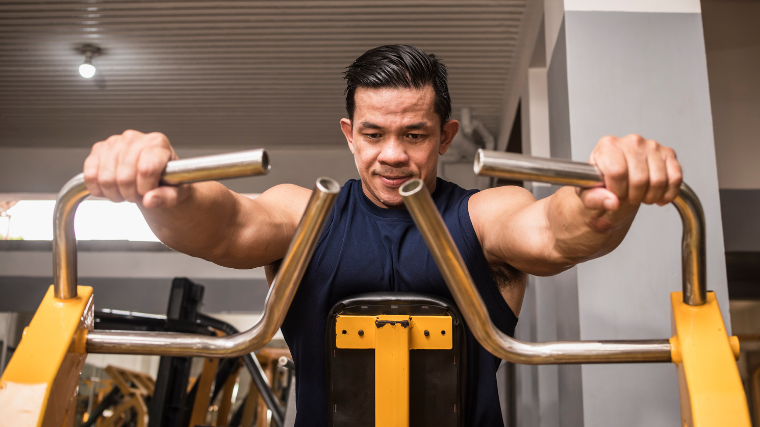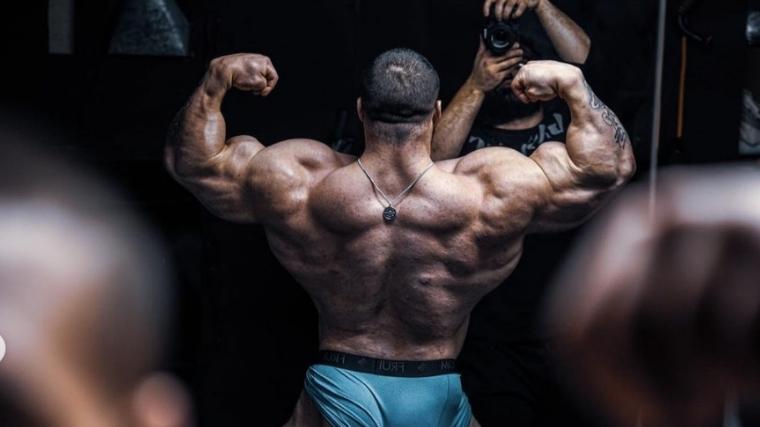Most commercial gyms come with a wide assortment of exercise machines. If you’re brand new to lifting weights, so many options can certainly be intimidating. You need to know which stations will serve your needs best.
When it comes to training your back, you can’t go wrong with the Hammer Strength® row. This equipment manufacturer has been a weight room mainstay for decades for good reason — their plate-loaded rowing machine is a foolproof tool for building up your lats, traps, and everything in between.
While Hammer Strength is renowned for offering a robust assortment of lifting machines that you can find in just about every weight room, their rowing station is a standout back-builder. Here’s how it works, and how to use it properly.
- How to Do the Hammer Strength Row
- Hammer Strength Row Sets and Reps
- Common Hammer Strength Row Mistakes
- Hammer Strength Row Variations
- Hammer Strength Row Alternatives
- Muscles Worked by the Hammer Strength Row
- Benefits of the Hammer Strength Row
- Who Should Do the Hammer Strength Row
- Frequently Asked Questions
How to Do the Hammer Strength Row
The Hammer Strength row station is a seated, horizontal, plate-loaded machine that trains the musculature of your upper back.
It also comes with several differently-angled handles for you to experiment with for the perfect grip. For the purpose of this how-to guide, you’ll perform the Hammer Strength row with an overhand, palms-down grip.
Step 1 — Set the Seat
The first and most essential step in your setup is to ensure that the seat is fixed at the proper height. Adjust it such that the torso pad rests against the middle of your chest at the top of your rib cage.
Coach’s Tip: You’ll know the seat is at the correct height if your arm is roughly parallel to the ground when you grip the handle.
Step 2 — Load the Plates
Once you’ve secured the seat at the proper height, load up the arms of the machine. The plates should slide cleanly onto the arms at the base of the machine.
Coach’s Tip: Consider doing a few unloaded practice reps to get a feel for how the Hammer Strength row moves.
Step 3 — Row the Handle

Once you’re loaded up and seated, grab each handle of the machine with an overhand grip. Your shoulders should protract forward while your chest rests flush against the vertical pad.
From here, initiate the movement by retracting your shoulders and then pulling your elbows back until they’re aligned with your torso.
Coach’s Tip: Allow the resistance to keep your torso firmly in contact with the pad at all times.
Hammer Strength Row Sets and Reps
One of the best parts of using a machine like the Hammer Strength row is its versatility. Since the station is easy to use and does not tax your stability, you can program it in a variety of different ways.
- For Muscle Growth: Try 3 sets of 8 to 12 reps, ensuring that you approach muscular failure.
- For Back Strength: Go for 4 sets of 6 reps with a heavy weight.
- If You’re Using One Arm: Try fewer sets with higher (12 to 15) reps for targeted lat activation.
Common Hammer Strength Row Mistakes
Exercise machines are often easier to work with than free weights like barbells or dumbbells, but that doesn’t mean that there’s no nuance to the Hammer Strength row.
Incorrect Seat Height
The Hammer Strength row is pretty easy to adjust and work with, but an improper seat height can really throw your performance into chaos.
Sitting too low (or too high) will affect your line of pull — how the muscles in your back align with the direction you’re applying force. If you’re sitting too low, you may find it too easy to use your arms and shoulders instead of your back.
Sit too high and the motion may feel awkward, as your lats won’t be able to contract effectively to pull the weight.
Pulling With Your Arms
The Hammer Strength row is a back exercise, through and through. While most row variations will involve your arms to some degree in an assistive manner, they shouldn’t steal the show.
Protracting your shoulders before you start is a great way to ensure you’re using your back. Allow your shoulders to roll forward and then actively retract them as you row, instead of simply bending your elbow.
Shrugging Your Shoulders
An improper seat height or poor mind-muscle connection might cause you to incorrectly elevate your shoulders while you row.
Your traps are extremely powerful muscles, and it can be very tempting to involve them in other movements. If you find yourself shrugging your shoulders up to your ears as you row, the weight you’re using might be too heavy for you.
Hammer Strength Row Variations
Exercise machines aren’t quite as versatile as, say, a cable station is. However, you can still make some small adjustments to the Hammer Strength row.
Single-Arm Hammer Strength Row
Each lever of the Hammer station is independent of the other. Meaning, you can work one side of your body freely while the other rests and row with one arm at a time.
This is a great way to focus on addressing a muscular imbalance if you think you have one. Similarly, you can alternate between arms while using the machine as intended.
Partner-Assisted Hammer Strength Row
Some tactical overload is a great way to induce extra muscle or strength gains. You can recruit the assistance of a spotter to help force you through reps that you couldn’t otherwise perform.
Simply have your assistant push gently on the handles as you row once you start approaching failure. This way, you can safely push your limits without worrying about dropping a bar or losing control of the resistance.
Hammer Strength Row Alternatives
If you don’t have the machine in your gym, or there’s a rude lifter hogging the equipment for far too long, you’re not out of luck yet. Try out these similarly-designed exercises to hit your back in a comparable way.
Seated Cable Row
If you’re after a more comfortable alternative to the Hammer Strength row, the horizontal cable row might be your best bet.
You’ll find that a seated cable row works your back in a similar fashion to the machine, but the resistance curve will be more consistent. However, most seated cable row stations won’t have a chest support to brace against. You’ll have to contract your core to stabilize your body while you pull.
Half-Kneeling Single-Arm Cable Row
You can still get a good back workout in while also taxing your core and hip musculature along the way.
If you want to make your rows more dynamic, assume a half-kneeling position in front of an adjustable cable tree and row with one arm at a time. This will still challenge your lats, but you’ll also have to stabilize your pelvis for the duration of your set.
Prone Dumbbell Row
A prone row, sometimes called a seal row, is a free-weight cousin of the Hammer Strength rowing machine.
The main difference here is that you’re pulling vertically with your arms hanging down, rather than horizontally. This won’t change which muscles are working, but the prone dumbbell row is likely to be much harder at the top of each rep and easier at the bottom.
Muscles Worked by the Hammer Strength Row
If you’re interested in working your back, the Hammer Strength row is right up your alley. The beauty of the machine is in its design — it removes the necessity to stabilize yourself, so you can focus on making each and every rep as perfect as possible.
Lats
Your back is an interlaced network of tissues that usually work together when you perform an exercise like the row. However, your latissimus dorsi muscles are the power players here.
Your lats span a large portion of your back, from your lumbar spine up to your shoulder. They retract and depress (or pull back and down) your shoulder blade, and are the prime movers in the Hammer Strength row.
Biceps
Your biceps brachii will also come into play during most rows, but they’re an assistive muscle at best as long as you have proper technique.
While half of the motion of the Hammer Strength row comes from moving your shoulders, you do complete the exercise by bending your elbow. That action is largely facilitated by your biceps and brachialis.
Upper Back
A compound exercise like the Hammer Strength row will involve a large assortment of muscle. Your rhomboids, middle and lower trapezius, infraspinatus, and even rear deltoids all perform a degree of work during the Hammer Strength row.
Since those tissues all originate or insert on the shoulder blade, they will bear a portion of the load. However, the mechanics of the exercise itself will ensure that most of the work is done by your lats first.
Benefits of the Hammer Strength Row
Like most Hammer Strength machines, the row station offers several functional benefits that aren’t exclusive to one single type of gymgoer. In fact, you might just be able to enjoy multiple benefits at once.
Good External Stability
Working on your joint stability and structural control is great, but you shouldn’t have to worry about it if you’re just trying to beef up your back.
A machine like the Hammer Strength row will remove almost all of the external stability demands you might have to deal with on a free-weight back exercise. This allows you to focus entirely on pulling as hard as you can, instead of worrying about whether or not you’ll fall over or lose control of the weight.
You Can Work Bilaterally or Unilaterally
The construction of the Hammer Strength row enables you to work with both arms at once, or use each lever independently.
This affords you more freedom of choice about how you use the machine to train your back. You can work your coordination by rowing with both arms at once, alternate which arm pulls and which rests, or simply load one side of your body at a time and turn it into a fully unilateral movement.
Easy to Load and Use
Exercise machines are by and large easier to work with than free weights or cables. This makes the Hammer Strength row a perfect beginner’s back movement, especially if you aren’t too keen on lifting free weights just yet.
All you have to do is set the seat and load up as much — or as little — weight as you want. After that, it’s straight to work.
Who Should Do the Hammer Strength Row
It doesn’t matter if you want to win the Mr. Olympia bodybuilding competition or are just interested in strengthening your muscles from head to toe. The Hammer Strength row can find a home in your workout routine.
Beginners
The functionality and ease-of-use make the Hammer Strength row a phenomenal beginner’s exercise. You can calibrate the resistance to precisely meet you where you’re at in terms of strength, and it’s a pretty intuitive piece of equipment overall.
Bodybuilders
The design of the Hammer Strength row makes it just right for torching your back and creating as much muscular hypertrophy as possible.
[Read More: Best Biceps Exercises for a Muscle-Building Workout]
Bodybuilding is all about finding the right tool for the job — if the Hammer Strength row gives you https://barbend.com/best-unilateral-exercises/a great contraction in your lats, it should probably be a mainline movement on your next back day.
If You Have a Muscular Imbalance
Make no mistake; a qualified doctor or physical therapist is the best remedy for addressing a physiological issue. That said, you can take proactive action and help prevent muscular imbalances by including some single-limb work into your sessions from time to time.
The independently-moving arms of the Hammer Strength row make it a perfect option for isolating one half of your upper back at a time.
Craft Your Back
Training your back doesn’t need to be complicated. Sometimes, the simplest solution is often the most effective.
An exercise like the Hammer Strength row lives up to that mantra and then some. Where other exercises have steep learning curves, the Hammer Strength row is straightforward.
Other movements tax your stability as much as your lats — the Hammer Strength row ensures your effort is directed where you want it to go. You have nothing to lose except potential back gains, so load up and get to work.
FAQs
If you have some nagging questions remaining about the Hammer Strength row, don’t worry. These answers will help drive the point home.
Can you load one arm of the Hammer Strength row at a time safely?
Yes. The machine is extremely stable and isn’t at risk of toppling over if you’re using it to train your back unilaterally. You can load one of the plate pegs at a time without worry.
Which handle of the machine should I grab onto?
You can adjust your grip style to target different muscles in your back. A medium-width overhand grip will hit your lats as well as the other muscles in your upper back; gripping wider and flaring your elbows will involve more of your shoulders and traps, while holding onto the neutral-grip handles makes the exercise extremely lat-dominant.
Featured Image: MDV Edwards / Shutterstock






